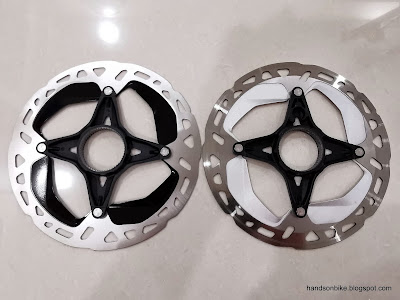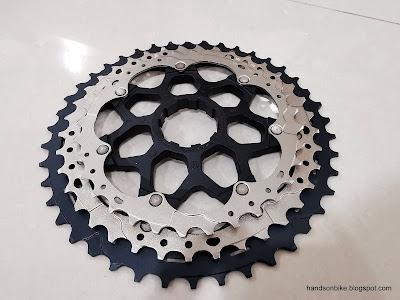I recently bought some new rotors, and it gives me a chance to do a quick comparison. The new rotor is the XTR MT900 rotor, which is very similar to the Deore XT MT800 rotor. I previously installed the MT800 rotors on two different bikes, the Canyon Endurace (gravel wheelset) and the Fnhon DB11 folding bike.
At first glance, these rotors look very similar, with only a different colour on the cooling fins. Let's take a closer look to see if there are any other differences.
Black paint on the cooling fins are claimed to help dissipate heat faster. Theoretically it is true, but does it make a discernible difference?
XTR MT900 rotor
Side by side comparison of MT900 vs MT800 rotors.
The cutouts are the same, and the shape of the cooling fins are the same as well.
View from the rear
XTR MT900 rotor has big cutouts at the back of the aluminium spider for weight reduction.
Deore XT MT800 rotor spider has an extra round holder, which is not used in this case. It is probably for the E-Bike type of rotor which has a magnet installed here for the speed sensor.
Weight of MT800 160 mm rotor, only 106 grams.
Add 8 grams for the aluminium lockring, and it weighs 114 grams.
MT900 rotor also weighs the same
Same lockring, thus same weight. 114 grams for 160 mm rotor (MT900/MT800).
As seen from the weight comparison, MT900 and MT800 rotors weigh the same. However, they are a bit lighter than the Dura-Ace RT900 rotors. You can also check out the comparison to the older RT99 rotors.
Trying out the MT900 rotors on the wheels.
Putting the rotors on the Hunt gravel wheelset to see how it looks.
Here is the RS770 wheelset as used on the Focus Paralane, it currently uses Dura-Ace RT900 rotors.
Changed to the new XTR MT900 rotors. Visually there is not a big difference.
Shown as installed on the Focus Paralane front wheel.
Rear wheel with XTR MT900 rotors.
Rotors changed from RT900 to MT900. Not a big visual difference.
The conclusion is that the MT900 and MT800 rotors are very similar, with only the colour of the fins separating it. They weigh the same and performance would be the same as well.
Ultimately which rotor you choose will depend on your budget and also the appearance. Some people like how the black cooling fins look, but it is also more expensive.
























































